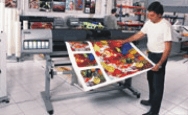|
>back<
Reproductions
now available
New
technology protects your investment and lets you enjoy the
paintings for decades.
Mads paintings are now available as high quality
reproductions. Recent printer advancements by Hewlett
Packard has led to the development of ink and specialty
paper, that can be displayed indoors under glass for
approximately 70 years before noticeable fading and
staining. The tests have been done by Wilhem Imaging
Research, Inc. These advancements are an improvement of many
of the current reproductions on the market, where 35 years
seems to be the norm.
Buy online
The
reproductions will be available in the Mads Shop in various
sizes, and in some cases it is possible to order custom
sizes. Limited editions, signed and numbered will be
offered. You choose if you want it framed or just the print
alone. I strive to only offer the best available in any
price range. I will not compromise with the quality. I put
as much care into a $40 print as a $2000 print.
Print vs. Giclee
Going to a gallery you probably can't avoid seeing the
word "Giclee". It sounds exclusive and expensive. In the
earlier days of printing, a special type of printer was used
to print art work. This type of print was called Giclee. It
does sound better than just "print", which we all probably
have tried on our computers. Nowadays, all reproductions are
made on regular commercial printers. In dealing with art, some
find that it sells better using the word "Giclee". However, I
can not support this tactic and call it for what it is.
Beware if a salesman tells you it is something
extraordinary. I do use a commercial printer that is above
the normal household printer quality, but basically it is
the same thing.
Highlights on reproductions
I just want to add that I do not do highlights on my
reproductions. Many artists like to add highlights, which is
regular paint that is added after printing. Some people
think this makes the painting look like the real thing. You
can usually see it, if you stand to the side of the painting
an look across the surface of the painting. You will in some
cases see a totally smooth surface with a few areas with a
layer of paint. Often it is in the white areas, because
these areas are not printed. A printer does not print white.
There is also a special varnish that gives a textured
effect, that cheats the unaware customer.
The reason for me not applying highlights is that it is a
reproduction, it is not an original. I also hardly leave
"highlights" or visible brushstrokes on the original
paintings, so it would be a misinterpretation of the
original to add it.
>back<
|

